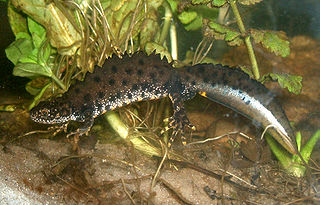
The great crested grebe is a member of the grebe family of water birds. The bird is characterised by its distinctive appearance, featuring striking black and white plumage, and elaborate courtship display that involves synchronised dances and displays.

The northern crested newt, great crested newt or warty newt is a newt species native to Great Britain, northern and central continental Europe and parts of Western Siberia. It is a large newt, with females growing up to 16 cm (6.3 in) long. Its back and sides are dark brown, while the belly is yellow to orange with dark blotches. Males develop a conspicuous jagged crest on their back and tail during the breeding season.

Grevillea, commonly known as spider flowers, is a genus of about 360 species of evergreen flowering plants in the family Proteaceae. Plants in the genus Grevillea are shrubs, rarely trees, with the leaves arranged alternately along the branches, the flowers zygomorphic, arranged in racemes at the ends of branchlets, and the fruit a follicle that splits down one side only, releasing one or two seeds.

Shrubland, scrubland, scrub, brush, or bush is a plant community characterized by vegetation dominated by shrubs, often also including grasses, herbs, and geophytes. Shrubland may either occur naturally or be the result of human activity. It may be the mature vegetation type in a particular region and remain stable over time, or a transitional community that occurs temporarily as the result of a disturbance, such as fire. A stable state may be maintained by regular natural disturbance such as fire or browsing. Shrubland may be unsuitable for human habitation because of the danger of fire. The term was coined in 1903.

Banksia ashbyi, commonly known as Ashby's banksia, is a species of shrub or small tree that is endemic to Western Australia. It has smooth, grey bark, deeply serrated, hairy leaves and spikes of bright orange flowers.

Cynosurus cristatus, the crested dog's-tail, is a short-lived perennial grass in the family Poaceae, characterised by a seed head that is flat on one side. It typically grows in species rich grassland. It thrives in a variety of soil types but avoids the acid and calcareous extremes of pH, and prefers well drained soils. It may be grown as an ornamental plant.

The dryandra moth is a species of moth that is considered to be the sole member of the family Carthaeidae. Its closest relatives are the Saturniidae and it bears a resemblance to many species of that family, bearing prominent eyespots on all wings. The common name is derived from the Dryandra shrubs of the genus Banksia, on which the larva of this species feed, and is hence restricted to the south-west of Western Australia where these shrubs grow. Other Grevillea shrubs may also be used as host plants.

The chirruping wedgebill is a medium-sized member of the genus Psophodes, which consists or four to five songbirds endemic to Australia. Commonly found in low shrublands in south-eastern inland Australia, the species is distinguished by its distinctive, chirruping call. The chirruping wedgebill and chiming wedgebill were considered to be a single species until as late as 1973, when they were separated due to marked differences in their calls.

Leucopogon parviflorus, commonly known as coast beard-heath or native currant, is a shrub or small tree in the family Ericaceae. It is native to all Australian states and territories excluding the Northern Territory and the ACT and also grows in New Zealand. The species can grow to between 1 and 5 metres in height and has leaves that are 11 to 29 mm long and 2.4 to 7.5 mm in width, often with curved tips. The white flowers are around 15 mm long and are produced in spikes of 7 to 13. These occur throughout the year.

Chamelaucieae is a tribe of flowering plants within the family Myrtaceae, mostly from Australia, with a few species in New Caledonia and south-east Asia.
Silver leaf or Silverleaf may refer to:

Hakea cristata, commonly known as the snail hakea, is a shrub in the family Proteaceae native to Western Australia. An ornamental prickly shrub with attractive foliage and creamy white rounded flowers appearing in profusion in the winter months.

Adenanthos argyreus, commonly known as little woollybush, is a species of erect shrub endemic to southwest Western Australia.
Enekbatus is a genus of ten species of small to medium Western Australian shrubs in the family Myrtaceae, moved from Baeckea in 2010.
Enekbatus bounites is a shrub endemic to Western Australia.
Enekbatus clavifolius is a shrub endemic to Western Australia.
Enekbatus cryptandroides is a shrub endemic to Western Australia.
Enekbatus dualis is a shrub endemic to Western Australia.

Enekbatus sessilis is a shrub endemic to Western Australia.
Enekbatus stowardii is a shrub endemic to Western Australia.













